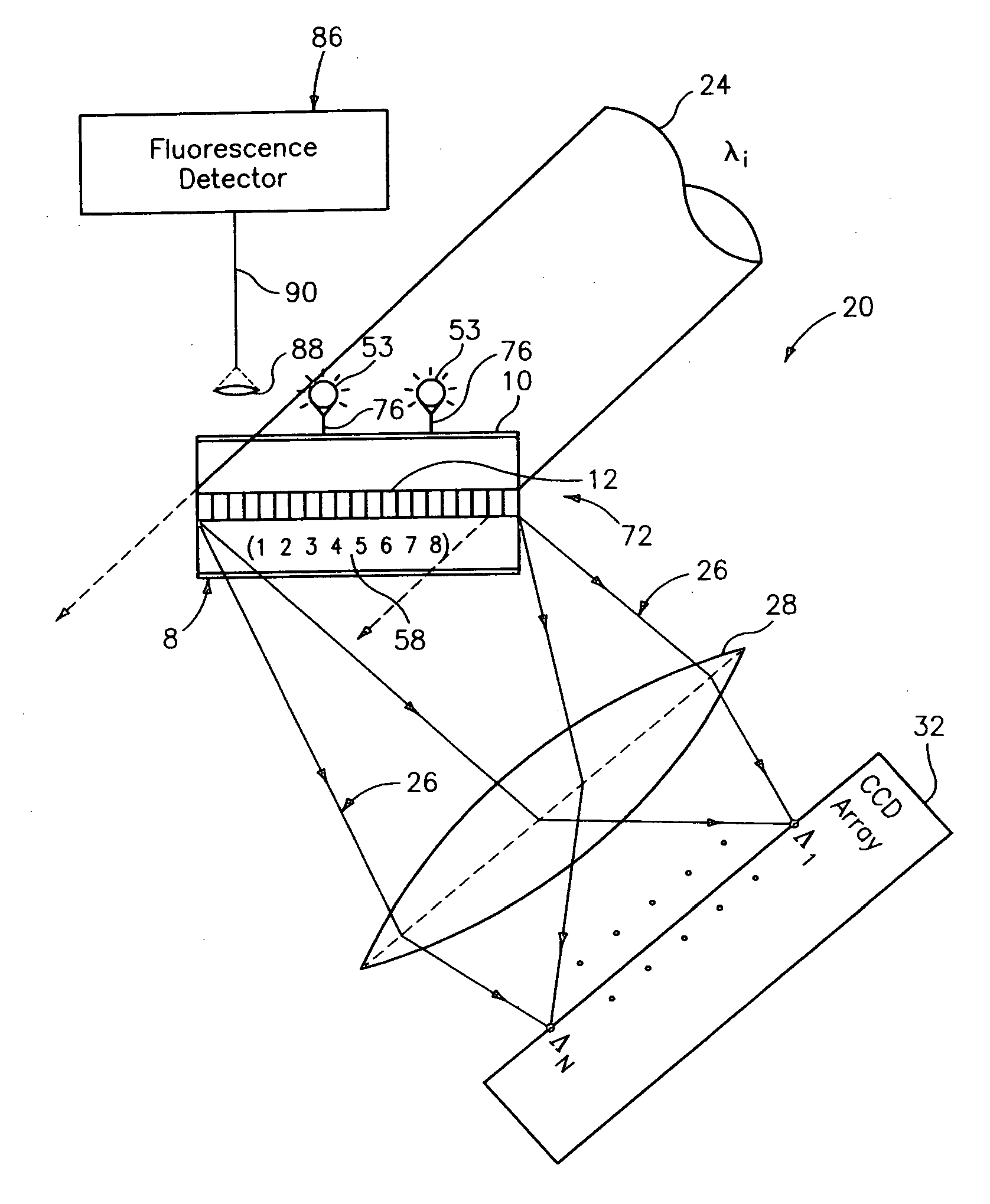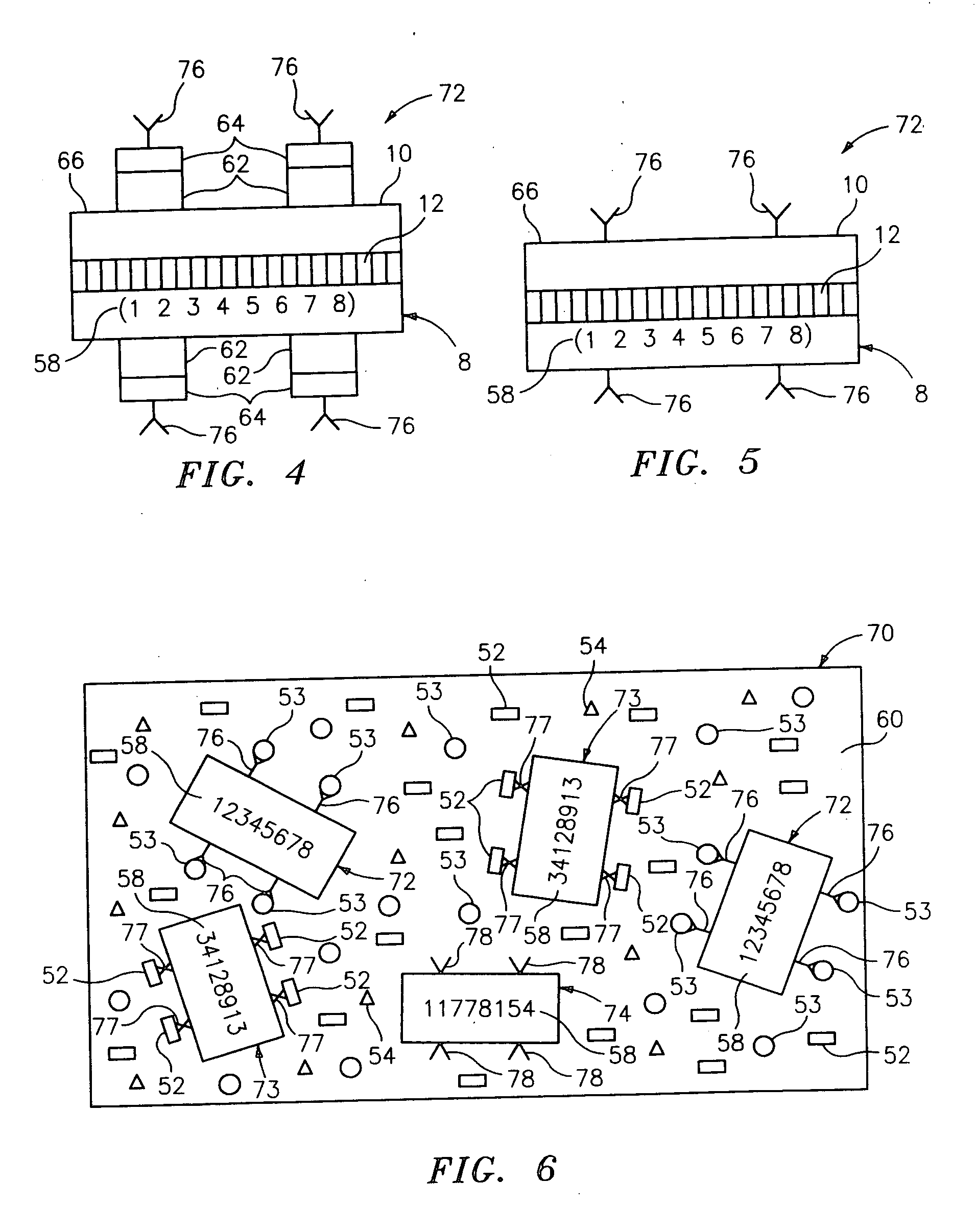Diffraction grating-based encoded element having a substance disposed thereon
a technology of encoded elements and gratings, applied in the direction of material analysis using wave/particle radiation, fluorescence/phosphorescence, instruments, etc., can solve the problems of limited planning or foresight employed, difficult to resolve adjacent spots, and impose spatial limitations on the process
- Summary
- Abstract
- Description
- Claims
- Application Information
AI Technical Summary
Benefits of technology
Problems solved by technology
Method used
Image
Examples
example 1
Preparation of a Reagent Particle Having an Oligonucleotide Reagent
[0428] This example illustrates preparation of an oligonucleotide reagent particle using an epoxide linker to bind the oligonucleotide to the particle. As shown in FIG. 44, a silica substrate 181 is reacted with ethyl-1-cyclohexylepoxide-2-triethoxysilane 182 (2% solution in 95% ethanol, pH adjusted to 5.0 using acetic acid) at room temperature for 1 hr (FIG. 44, panel a)). The product is a silanated derivative of the silica substrate bearing pendant cyclohexyl epoxide linker moieties 183. A primary amine-derivatized generic oligonucleotide 184 having a desired sequence is reacted with the derivatized substrate 183 in aqueous buffer pH 9.5 for 1 hr (FIG. 44, panel b)) to form the vic-hydroxycyclohexyl-oligonucleotide secondary amine 185 as the product, the intended oligonucleotide reagent. The oligonucleotide reagent particle may be suspended in a suitable buffer to constitute an assay composition useful to probe fo...
example 2
Preparation of a Multicomponent Article Having an Oligonucleotide Reagent
[0429] This example illustrates preparation of an oligonucleotide reagent-bearing article using an aldehyde linker to bind the oligonucleotide to a substrate. A silica substrate 181 is reacted with a normal alkyl aldehyde triethoxysilane 186 under the same conditions as in FIG. 44 (FIG. 45, panel a)). The product is a silanated derivative of the silica substrate bearing pendant normal alkyl aldehyde linker moieties 187. A primary amine-derivatized generic oligonucleotide 184 having a desired sequence is reacted with the derivatized substrate 187 in aqueous buffer pH 7.5 for 1 hr (FIG. 45, panel b)) to form the Schiff-base oligonucleotide adduct 188 as the product, the intended oligonucleotide reagent. The latter may further be stabilized by reduction of the Schiff base to form a saturated secondary amine group (not shown). The oligonucleotide reagent article may be suspended in a suitable buffer to constitute ...
example 3
Preparation of a Reagent Particle Having a Protected Thymidine Reagent
[0430] This example illustrates preparation of a nucleotide reagent particle bearing a protected thymidine derivative using an amine linker to bind the nucleotide to a particle. A silica substrate 181 is reacted with an ethylamino-N-alkylamine trimethoxysilane 189 using the same conditions as in Example 1 (FIG. 46, panel a)). Any alkylaminotrimethoxysilane or alkylaminotriethoxysilane may be used; in the embodiment shown in FIG. 46 the reagent is N-(6-aminohexyl)aminopropyl-trimethoxysilane. The product is a silanated derivative of the silica substrate bearing pendant ethylamino-N-alkylamine linker moieties 190. 0.1 M (or about 20-fold excess over linker groups) 5′-dimethoxytrityl deoxythymidine-3′-(N,N-di-isopropyl)phosphoramidite cyanoethyl ester 191 is reacted with the derivatized substrate 190 in acetonitrile in the presence of tetrazole or similar activator (5-ethylthio-1H-tetrazole; 4,5-dicyanoimidazole; 5-...
PUM
| Property | Measurement | Unit |
|---|---|---|
| length | aaaaa | aaaaa |
| diameter | aaaaa | aaaaa |
| size | aaaaa | aaaaa |
Abstract
Description
Claims
Application Information
 Login to View More
Login to View More - R&D
- Intellectual Property
- Life Sciences
- Materials
- Tech Scout
- Unparalleled Data Quality
- Higher Quality Content
- 60% Fewer Hallucinations
Browse by: Latest US Patents, China's latest patents, Technical Efficacy Thesaurus, Application Domain, Technology Topic, Popular Technical Reports.
© 2025 PatSnap. All rights reserved.Legal|Privacy policy|Modern Slavery Act Transparency Statement|Sitemap|About US| Contact US: help@patsnap.com



